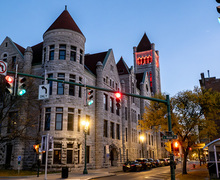Built to win: Landscape architecture students win national award for design to help plankten, algae reproduce in Hudson River
Andy Casadonte | Art Director
Four students in SUNY-ESF’s landscape architecture program received a national award in Boston on Saturday for their class project to increase the productivity of plants in the Hudson River.
The award comes less than a month after U.S. News & World Report named the State University of New York College of Environmental Science and Forestry’s landscape architecture program as the 13th-best in the nation.
The project, called “Primary Productivity in the Hudson River Estuary,” had ESF students trying to reduce the speed of water flow to better allow primary producers — like plankton and algae — to reproduce, said Gena Morgis, a fourth-year landscape architecture student and one of the students who received the award.
The American Society of Landscape Architects judges student projects alongside the work of professional landscape architects for the national award, said Ben Boisclair, a fourth-year landscape architecture student. The project won the award in the research category and is being recognized as an innovation in estuary technology.
The research category received the second largest number of submissions, Douglas Johnston, professor and chairman of the landscape architecture department, said in an email. They received more than 100 projects from both undergraduate and graduate students, which speaks highly to the students and professors, he said.
The amount of work in the landscape architecture major can sometimes be overwhelming, Morgis, a student involved in the project, said. But many students are passionate about design and dedicated to creating something meaningful, she added.
Being a landscape architecture student is exciting, said Kevin Nagle, a fifth-year landscape architecture student. There are endless limits and applications of what landscape architecture students can pursue and achieve, he added.
The department has received consistently high rankings, Nagle said. A lot of the success of the program can be attributed to how tight knit the landscape architecture community is, because of a mutual feeling that the students are “all fighting the same fight,” he said.
“The rankings are kind of like bragging rights, but it’s nice to know that your small school can stand against others,” he said.
Ariana Muca, a fifth-year landscape architecture student, said the major is special because it’s the only design-focused program at ESF.
“The program is more like a job than a major. All of our classes are related to the major, so it’s like having a real job,” she said.
The landscape architecture program at Cornell University consistently ranks close to ESF’s in the U.S. News & World Report. According to the rankings, Cornell and ESF have two of the three best landscape architecture programs in the east.
The landscape architecture department at ESF differs from Cornell’s program, due to it focusing on environmental research, Morgis said. The relationship with Syracuse University provides the ESF landscape architecture program with resources and “allow us to push our boundaries,” she added.
All accredited landscape architecture programs are guided by standards established by universities and people in the profession, said Johnston, the professor and department chair in landscape architecture. But ESF offers off-campus programs and more interaction with the faculty, he added.
Johnston feels that the surveys to determine the high rankings have limited validity because the criteria vary from year to year. The main purpose of the rankings is to sell magazines, but many people still take them seriously, he said.
Said Johnston: “However, to us, the high ranking reinforces what is well known by those within the university: the landscape architecture department at ESF is the premier program with outstanding students, faculty and alumni.”
Published on November 17, 2013 at 11:50 pm





